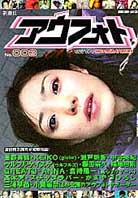Out of Photographers magazine
 Review of Out of Photographers magazine. Publishes photos submitted by readers and celebrities. Ceased publication in 2000.
Review of Out of Photographers magazine. Publishes photos submitted by readers and celebrities. Ceased publication in 2000.
Reviewed on: March 14, 1998 Last modified: 2005-04-03 Published: Quarterly (ceased) Publisher: Shinchosha Price in Japan: ¥780 Size: B5, 176 pp. Language: Japanese
This is another image-intensive publication with a potpourri of color images of all sizes and kinds. The image suppliers are the magazine's readership which includes Japanese celebrities and non-celebrities. People and their private lives are the main themes.
The magazine serves to publish photos taken privately for fun or as a hobby. It contains some interesting and often humorous pictures. We also get to see photos taken by celebrities dabbling in photography such as Miho Kanno (on the cover of issue No. 3 pictured above and the subject of the photo book NUDITY), Asaka Seto (who starred in the recent "Narita Rikon" TV series), teen idol Mariya Yamada, Miki Nakatani, Nobuyoshi Araki, and singer Sharan Q. It's surprising to see how many Japanese celebrities have taken up photography as a hobby. They probably just joined the crowd amid Japan's photography boom. All of a sudden, it's fashionable to take pictures. And if you're a young celebrity, you have to look fashionable and hip.
Each issue of Out of Photographers features photos by celebrities, non-celebrities, and theme-based photos (funny faces, sleeping faces, peace-sign poses, group photos, private photos, photo collages, etc.). A large number of photographers contribute to the magazine. The amount of space given to a contributor varies widely from one photo to a multiple-page spread. On the last page of the magazine, there is an apology to a list of people who sent in photos but were not published. What a nice touch. You get to see your name in print anyway even if your photos don't make the cut.
Costing only 780 yen, this magazine is quite cheap considering the large number of color photos and the relative scarcity of advertising (which are difficult to distinguish from the contributors' works). We have been seeing a number of new photo magazines which center on photographs sent in by amateurs (mostly teenagers). The magazines get to use the photos for free, and the contributors receive the thrill of seeing their photos and names published. Everyone benefits from this arrangement. Of course, readership participation is nothing new in magazine publication. Many camera magazines in Japan solicit photos from the readership. However, photo magazines whose sole purpose is to publish photos submitted by readers is a recent phenomenon. (Reviewed by Philbert Ono)